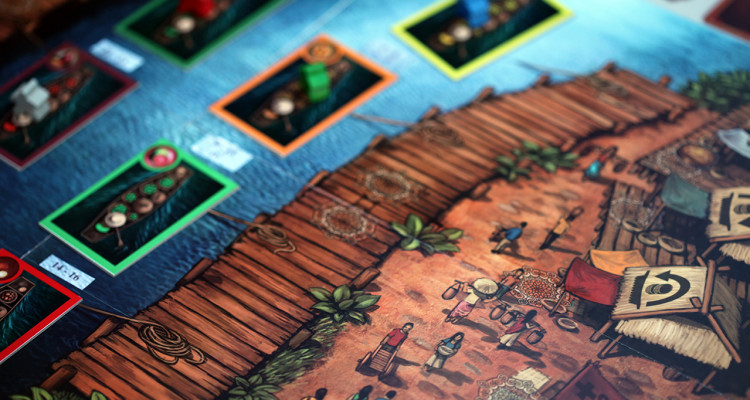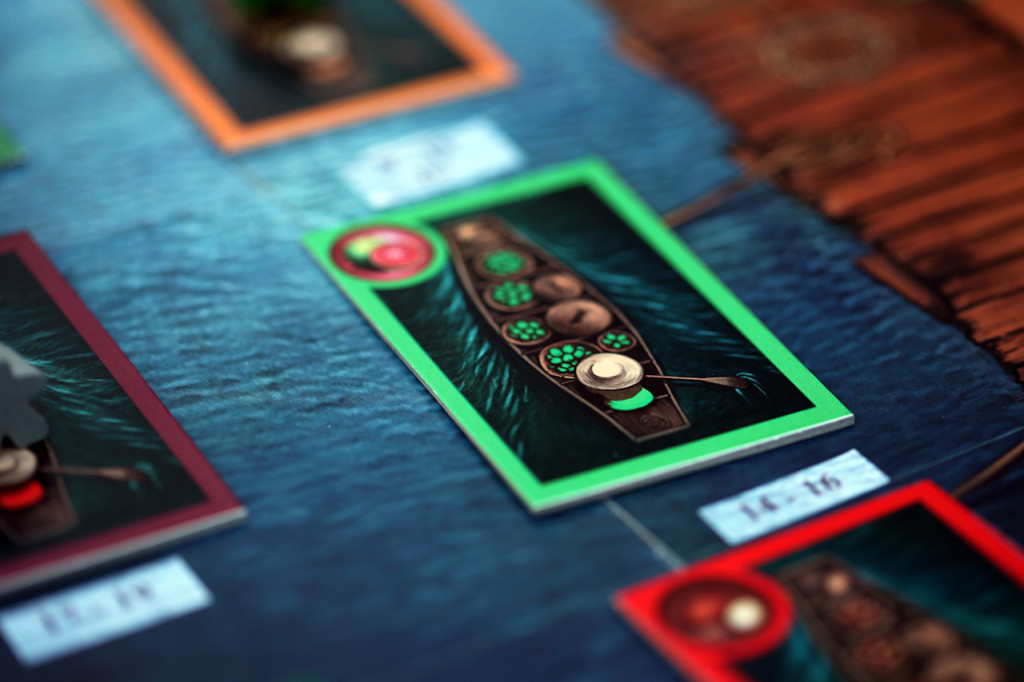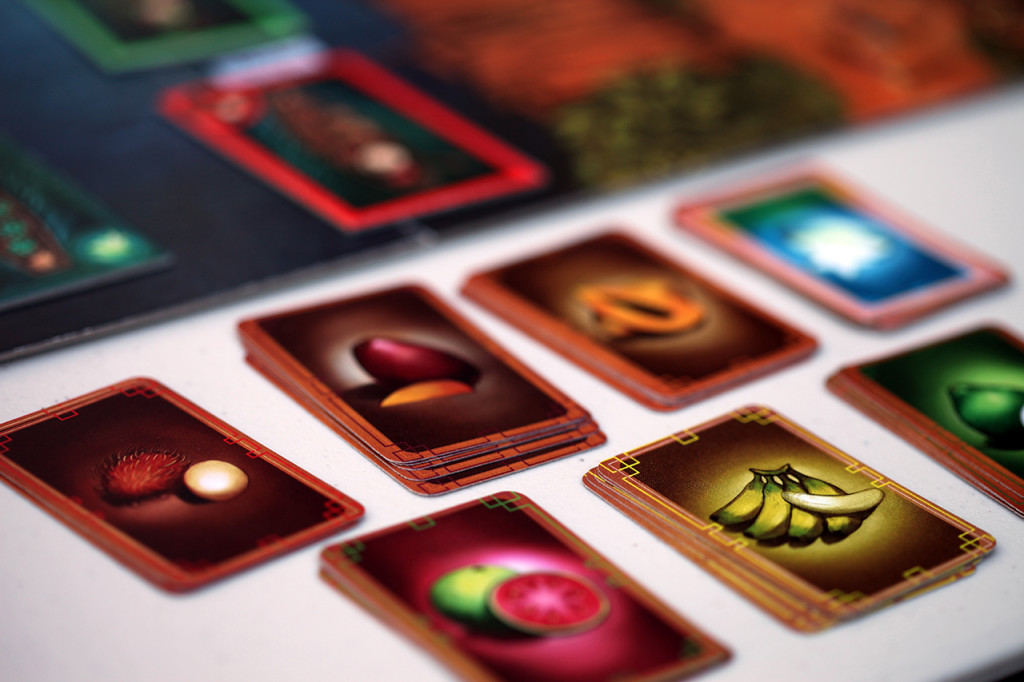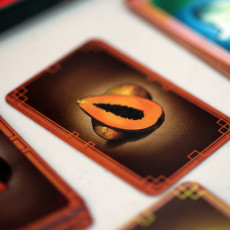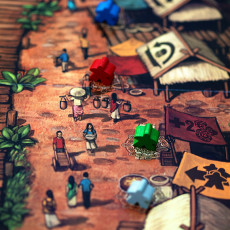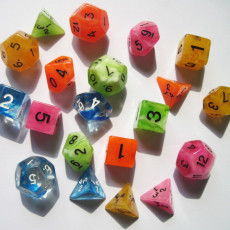Ama (Grandma) is tired. It has been a long day of chasing grandchildren, and she needs a break. Ama has been around for a long time and she has a few tricks up her sleeve. With the promise of her famous Fruit Salad, she sends her grandchildren down to the Damnoen Saduak Floating Market to collect Fruit… and to get out of her hair! Collecting the different fruit for the salad is no easy task, as the Fruit Boats – full of Mango, Banana, Papaya, Pineapple, Grapefruit, Rambutan, and the famous Starfruit – are constantly shifting around the Khlong Damnoen Saduak Canal. But, the competitive grandchildren have a few tricks up their sleeves as well…
Floating Market, from designers Matt Riddle and Ben Pinchback, is a game for 2-5 players that combines euro-style worker placement and dice speculation in a unique and fun way. What’s so unique about that, you ask? The answer is polyhedral dice! You will be given a set of five polyhedral dice – a D4, two D6s (one counts as a negative die), a D10 and a D12 – in combination with a number of action spaces that are available to manipulate and mitigate the results of each round. You and your friends are vying to be the first to collect five different pieces of fruit to bring back to Ama for her salad. This can be accomplished by correctly wagering on the fruit boats and/or buying the fruit outright at the market using coins you’ve collected.
A round in Floating Market is broken down into three phases – Assign Customers, Collect Fruit, and Round End. During the Assign Customers phase, you will receive three workers to assign to one of the seven boats in order to collect fruit and/or to the eleven buildings to gain special abilities. After your first customer placement every round, you will select one of your polyhedral dice to add to the dice pool in an attempt to influence the end-of-round dice roll that determines which fruit boat will pay out. The buildings aid your ability to sway the activation value of the dice pool in your favor as well as enhance the bonuses you can receive (i.e. additional coins).
As mentioned before, Floating Market, at its core, is a blend of worker placement and dice speculation. During each round, the die you select directly impacts the potential outcome of the end-of-round results. As each die may only be used once before having to give up an action to retrieve them, wise usage of your limited resources is important, as is trying to determine what your opponents will attempt with the dice they have available. That being said, turn order can play an important role in determining the die you select for the pool as well as your initial customer placement. The earlier in the turn you go, the less of an opportunity there is for you to fully grasp the potential outcome of the dice pool, making initial customer placement on a boat more haphazard. The later in the turn order you are, the higher your chances of predicting the outcome; however, the spaces available to you may not be as advantageous, as a majority of them are limited to one customer.
After you have placed all of your customers, it’s time to do what you’ve come here for: collect fruit. The Collect Fruit phase pays out in both fruit, and a number of coins based on your customer placement on the boats. The current start player rolls the dice in the dice pool and calculates the activation value by adding the values of all the positive dice and subtracting any negative dice values. You then compare the final value to the activation ranges of each boat to determine which one will pay out this round. The customer on the activated boat receives the coveted fruit card, while customers on the two adjacent boats each receive two coins. Remember to also check the building powers as these can provide you with fruit and/or additional coins. For instance, the Fruit Stand allows you to score a piece of fruit if a boat adjacent to your customer pays out and the Docks give you an additional coin if on the same side of the river as the activated boat.
At the end of the round, you will set all the dice in the pool to the side. These dice are no longer available until you retrieve them with one of your customers. The current starting player then switches the positions (and thus, the activation value) of two boats and passes the starting player marker to the left. The game continues until someone has collected five different pieces of fruit for Ama.
I was pleasantly surprised by how much I enjoyed this game. While games with dice will always contain a luck factor, there is a layer of strategic depth to be found in the placement of your customers and the utilization of the building powers. You could visit the Fishmonger to place a customer on a previously occupied boat, or wander over to the Aritst’s Hut, Woodworker’s Stall or Tailor to add or subtract from the existing dice pool. There’s also the Office, which allows you to place all of your remaining customers in one action. If timed correctly, strategic use of these options could pay huge dividends, as they provide a number of ways to manipulate and mitigate the fallout of the dice roll. Remember though, despite your best efforts, the final results are always in the hands of the dice gods.
The emergent social elements of this game were initially hidden when first reviewing the rules and without these elements the game would fall flat for me. It’s not until you sit down to play that you realize that there is a definite gamesmanship at work most rounds. You and your friends will constantly be haggling with each other in order to sway the dice pool higher or lower. When speaking with Matt and Ben about the design (The Podcast of Nonsensical Gamers – Episode 15), they stated that their aim with Floating Market was to create a euro-style game that also elicited an emotional response from the players. The end-of-round dice pool is tense and presents a number of “ooooooh!” moments akin to popular dice games like Las Vegas or Camel Up. Seeing the end result of your speculative manipulation is a very rewarding feeling when you succeed; and even when you don’t collect the coveted fruit, there are still ways in which your customer placement can grant you additional coins that can in turn be cashed in at the Market for a fruit of your choice later. Your success in Floating Market, will ultimately depend on your ability to balance the luck of the die with the strategic placement of your customers.
Floating Market has managed to incorporate polyhedral dice into a euro-style worker placement game to create a fun and accessible experience for gamers of all levels. The theme is unique, the art is beautiful and the game play is engaging, quick and easy to grasp. If limited luck, perfect information and hardcore strategic gameplay are what you are looking for, this game will likely not appeal to you. If you’re looking for a fun and refreshing mixture of worker placement and dice speculation, I highly recommend you roll down the river and check out Floating Market.
The League of Nonsensical Gamers would like to thank Matt Riddle and Ben Pinchback for kindly providing us with a prototype of Floating Market for this preview.
Floating Market is currently funding over on Kickstarter. If this game piques your interests, row on over to the campaign page by March 11, 2015 to purchase your own copy. For $29 (plus $10 shipping), you will receive a copy of the game along with all of the stretch goals that have been attained.

